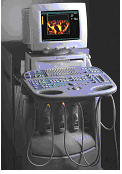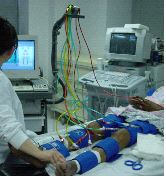Non-invasive Vascular Ultrasound Tests
University Hospital Vascular Ultrasound Lab
University Hospital
150 Bergen Street, D-447
Newark, NJ 07103
Phone: 973-972-4138
map
Jersey City Vascular UltrasoundLab
Jersey City Medical Center
355 Grand St, Second Floor
Jersey City, NJ 07302
Phone: (201) 915-2448
map
Non-invasive Vascular Testing
The vascular laboratory is an important part of our vascular center. The tests performed are noninvasive without causing any pain or discomfort. The blood vessels (veins and arteries) of the patients are evaluated using Doppler ultrasound techniques. Diagnosis of almost all diseases of the blood vessels can be made at the same time their severity is being assessed. Color flow duplex scanners are being used with different probes that are applied over the skin with gentle compression to examine the blood vessels in the different parts of the body. Many different tests are available in our vascular laboratory. These include imaging of...
Carotid and vertebral arteries in the neck - Disease within these vessels are often responsible for strokes that may lead to paralysis of the extremities, speech problems, loss of balance and also death.
Arteries in the arms and legs - Blockages of the arteries in the lower extremities are often responsible for leg pain during walking (intermittent claudication) and at rest (rest pain). When it is severe enough, it can lead to gangrene and loss of the limb.
Aorta - The biggest artery in the body. Dilatation of this vessel (aneurysm) is the most frequent pathology. When it ruptures, the outcome is usually fatal.
Mesenteric arteries - The blood supply to the intestine. Occlusion of these arteries may lead to intestinal ischemia. Patients may experience weight loss and fear of eating food.
Renal arteries - The main arteries to the kidneys. Narrowing of these arteries can produce high blood pressure which is difficult to control with medication.
Veins in the neck, abdomen and extremities - The most common pathology is the formation of blood clots (deep venous thrombosis) that can travel to the lungs (pulmonary embolism) and can be fatal.
Veins in the lower extremity that can develop reflux (blood traveling in the wrong way). This happens in patients with varicose veins. The veins dilate and the blood stays in the limbs instead of going back to the heart. This may cause pain, itching, burning sensation, swelling, discoloration of the skin and in severe cases ulcers.
Physiologic testing with the aid of Doppler devices and plethysmography are being used to detect the pulse and the pressure in the extremities. These are very cost effective tests to screen arterial blockage and assess also the severity for the disease.
Duplex Ultrasound

Pulse Volume Recording & Segmental Pressures

